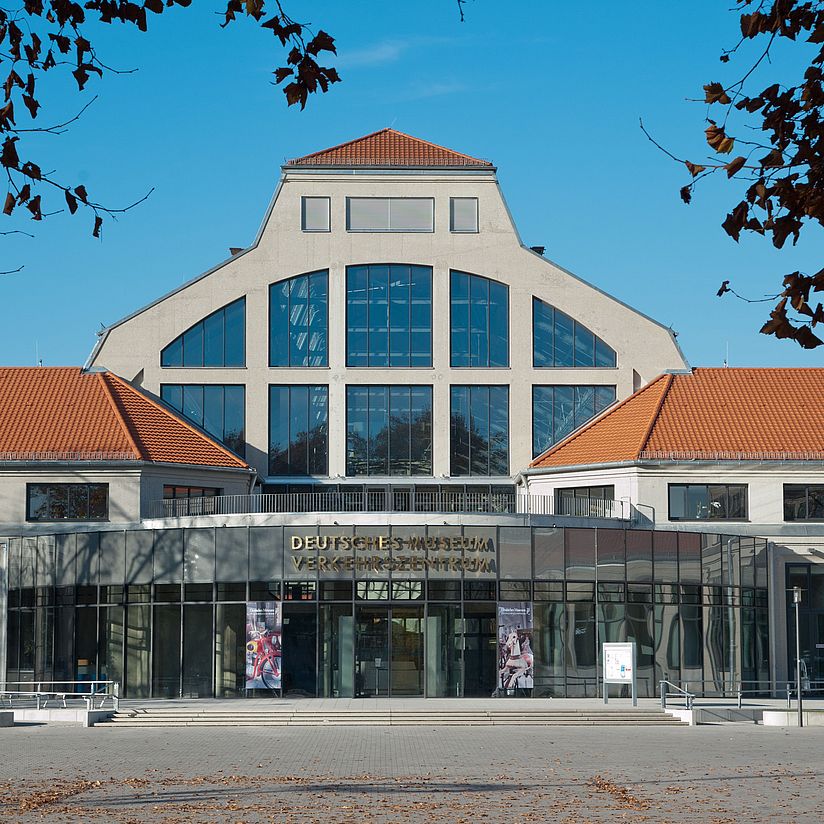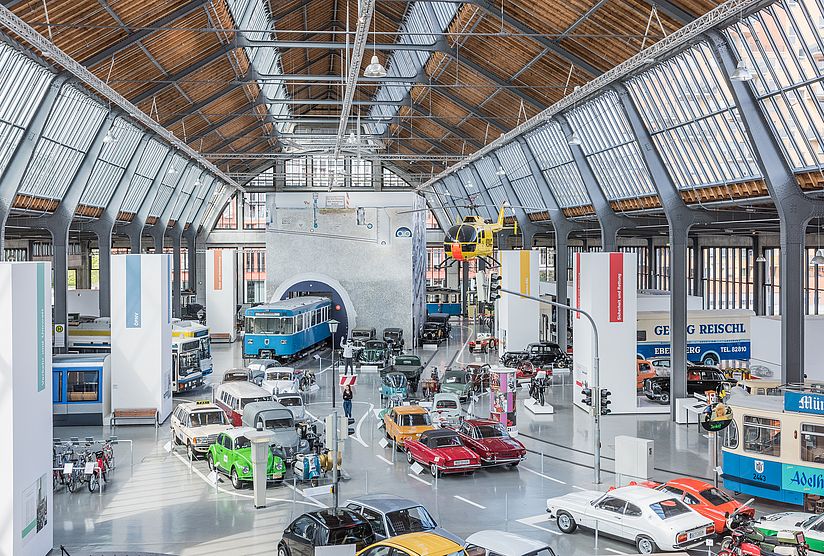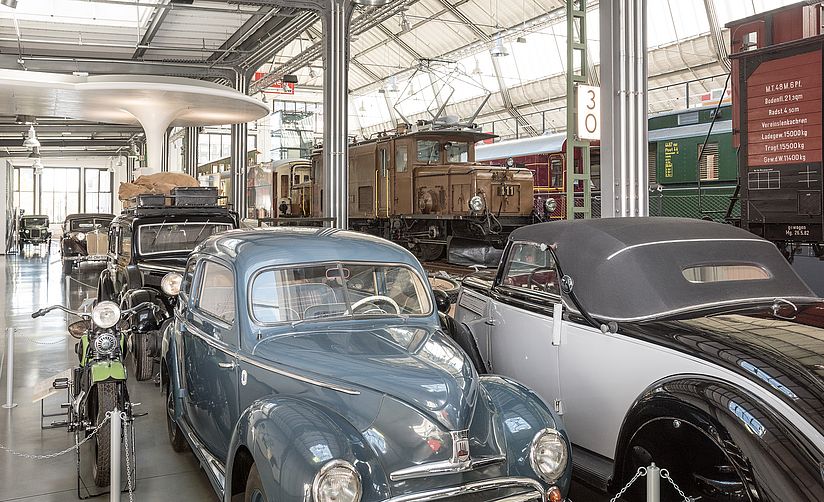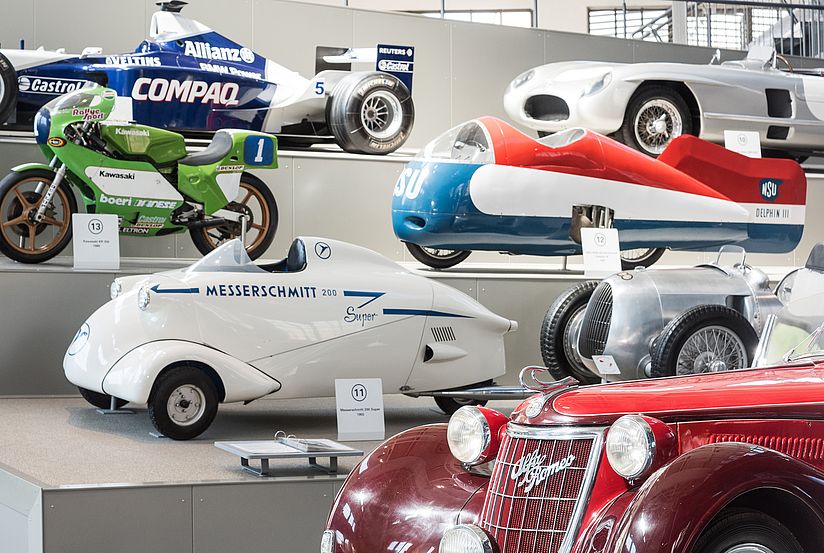
Photo: Deutsches Museum
The Transport Museum (Deutsches Museum Verkehrszentrum)
Fascination on tires, rollers, wheels
The Transport Museum (Deutsches Museum Verkehrszentrum) brings the past, present and future of land transport to life.
All aboard, please! In the Transport Museum, visitors learn everything about locomotion on tires, rollers, wheels and skids. From the draisine, the forerunner of the bicycle, to the first gasoline-powered car (Benz-Patentmotorwagen) to the modern ICE, numerous originals take visitors through the history of land transportation. In the process, the three halls on Munich's Theresienhöhe are not just lined up with unique exhibits. The contemporary exhibition concept makes it possible to experience the many aspects of human mobility. Divided into the sections "Urban Transport," "Travel" and "Mobility and Technology," the exhibition highlights not only the technical aspects but also the economic, political, social and cultural dimensions of transport yesterday, today and tomorrow. The walk-through exhibits make a visit to the transportation center a complete experience – from the truck driver's cab to the railroad mail car to the carriage simulator, the motto at many points is: All aboard, please!
It is not only the magnificent collection and the way it is presented that promise a unique experience at the Transport Museum – the listed exhibition halls themselves are also well worth seeing: the ensemble, which opened in 1908, was planned by the architect Wilhelm Bertsch. After the Munich Trade Fair moved out, the Deutsches Museum took over responsibility for the renovation of the buildings in accordance with the preservation order from 2002 onwards. Hall III, the first part of the Transport Museum, was opened in 2003. Three years later, Hall I and Hall II followed. Finally, in 2011, the newly constructed entrance area with adjoining offices, small lecture hall, visitor foyer, ticket office and store completed the branch of the Deutsches Museum.
Hall I

The vehicle collection is presented on a street that runs through the hall as a time axis. Photo: Deutsches Museum
Urban Transport
The development of urban transportation and traffic in metropolitan areas are the theme of Hall I. The vehicle collection is presented on a street that runs through the hall as a time axis. In the center of the hall, the street widens into a large plaza staging with "side streets". Here, automobiles, two-wheelers, three-wheelers, streetcars, buses and special vehicles such as a historic removal van or a street sweeper are on display. Historical and futuristic traffic lights along the road document the technical development of traffic control. Visitors can climb aboard a subway train, experience traffic from the perspective of a truck driver, or peer inside a Klinomobil – a mobile dentist's office from the 1960s. Grouped around the display collection are the themes of "Public Transport," "Environment" and "Safety." Crash tests are shown, and visitors can see how an airbag works or how a rescue chain works.
Hall II

View of Hall II. Photo: Deutsches Museum
Travel
The path through the exhibition hall begins with a look back at the travel-loving Romans and the difficulties of pilgrimage. From carriage travel to the package tour of the present day, the path continues along a variety of means of travel: past the Swiss Alpine Post, which traveled over the Furka Pass until the 20th century, the first continental horse-drawn streetcar "Hannibal," the S 3/6 express steam locomotive with mail and dining cars, or the Kässbohrer Setra panoramic bus. Carriages, automobiles, motorcycles and bicycles tell the story of travel by road. In addition to the first three-wheeled vehicles, exhibits include the Mercedes Simplex, considered the model for the basic shape of the automobile, luxury sedans such as the Mercedes SS or Lancia Lamda, the "Laubfrosch," the first assembly-line manufactured car in Germany, and a pink Cadillac from the 1950s. The hall's attractions also include a carriage simulator that gives visitors an authentic feeling of sitting and driving as in Mozart's day.
Hall III

Racing cars in Hall III of the Transport Museum. Photo: Deutsches Museum
Mobility and Technology
The theme of this hall is man's urge to move and the technical tools that help him move fast, far, safely and effectively. The exhibition covers everything from acceleration on one's own feet - from bone skates to high-tech inline skates ¬ to the development of motor sports, using the example of prominent racing cars such as the Audi Alpine champion, to the fundamentals of vehicle physics. Unique exhibits such as the Benz Patent Motor Car or the steam locomotive "Puffing Billy" bring the history of mobility to life.
The Transport Museum
The Press Release for Download
TransportMuseum (PDF 9 MB)
